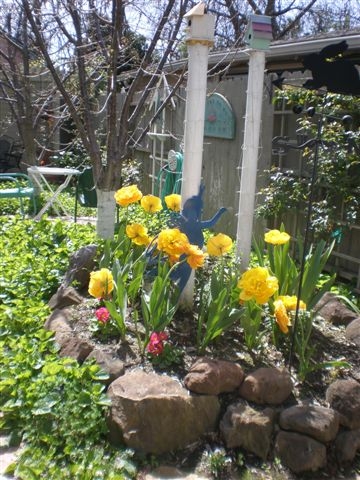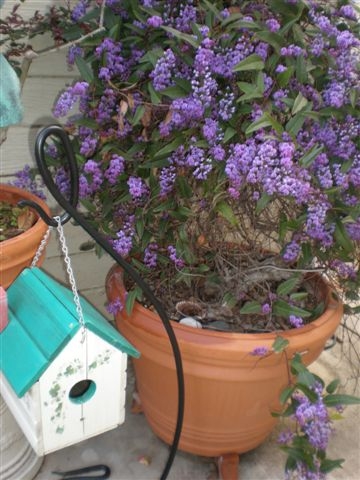- Author: Betsy Lunde
As I look out at the rainy weather and watch weeds gaily thrusting forth from the soil, I cough, again, and wonder about the latest offerings from the seed and plant catalogs beside me. Should I try this one – Arenaria ‘Wallowa Mts'-- Moss Sandwort ? How lovely, a form of sandwort that has tiny evergreen leaves and doesn’t flower. “Neat looking and tidy”; sounds so fab, but wait, not for my growing zone, only for 4-8. Drat!!
I’ve been doing this now, the reading and wanting, for the last few hours. In between coughing fits and nose blowing, I’ve managed to find almost everything in this catalog from High Country Gardens Santa Fe New Mexico that is not for this area or that needs special care only a greenhouse can provide in this area.
I want to be working in the yard, continuing my never ending battle with pruning shears in hand. Didn’t I just buy a new blade for my Felcos just for this war? The shears are now just sitting idle looking rather sad and forlorn as though I abandoned them for life! Sorry guys but I can’t go outdoor, I have a bad cold – this is the worst one-week vacation I’ve taken in years!
I put in for my vacation with the boldest of plans: prune roses and the other shrubs in the yard; purchase new seeds for the annuals that will look wonderful in the empty pots around the patio (various zinnias and other annuals); check out Annie’s Annuals catalog for must haves and then get them; and just putter around the garden as though I was in charge and not those birds who are fighting over which shrub and old nest is whose.
What did I get instead? I’ll tell you: a surprise trip out of town for three days and a cold which came with a bark of a cough. You know it’s bad when your sister-in-law in the next hotel room thanks you for keeping her up all night! But that was then and now is now.
Now it’s dry and the wind is blowing like crazy; on the horizon to the West is another dark bank of clouds coming this way. I know if I had just stayed at work that there would be no rain or gloom.
But looking out another window, my “star magnolia” (Magnolia stellata) is blooming away – though the winds and rain are pounding at it, that little tree is covered in the white, long-petaled blossoms. It is proof that Spring can’t be too far behind. I have to stop writing and musing now, coughing and sneezing have waited long enough for my attention!
- Author: Karen Metz
This time of year I start to get really excited. The San Francisco Flower and Garden Show is coming up; this year it runs from March 21-25. It's been a tradition for my mother and I to go together. Usually we go on a Friday. Some years we run into a group of Solano County Master Gardeners who also have a tradition of going to the show together. I have great memories of the shows.
When I first started going they were at the Cow Palace, their home for many years. I continued to go when they moved to the San Mateo Event Center. Further changes occurred when the management changed hands, but it has continued to be a wonderful experience.
Why go? After all it's a long drive. First of all the exhibits, you will see plants you've never heard of in colors you've never dreamed of. Secondly new ideas for plants you are familiar with, sod and grass roofs, succulent walls, or edibles grown decoratively in your front flower beds. Thirdly, go for the intoxicating experience of being surrounded by people just as enthusiastic about flowers and gardening as you are. Lastly, there is the shopping.
The shopping deserves its own paragraph. There is usually the most wonderful collection of vendors: dahlias, succulents, orchids, drought tolerant, you name it. There are also handy garden tools, garden inspired clothing and jewelry, and garden art. There is just about anything garden related that you can think of. Just touring my back patio reminds me of various years at the flower show. I love my Harry Lauder's Walking stick, Corylus avellana 'Contorta", with it's wonderfully twisted branches. Then there is my weeping pussy willow that I haven't seen elsewhere. Finally there are my wonderful blueberries that are special varieties that can do well this far south. They are wonderfully tasty as well as pretty and in full bloom right now. Who knows what I will find this year; did I mention I was excited?
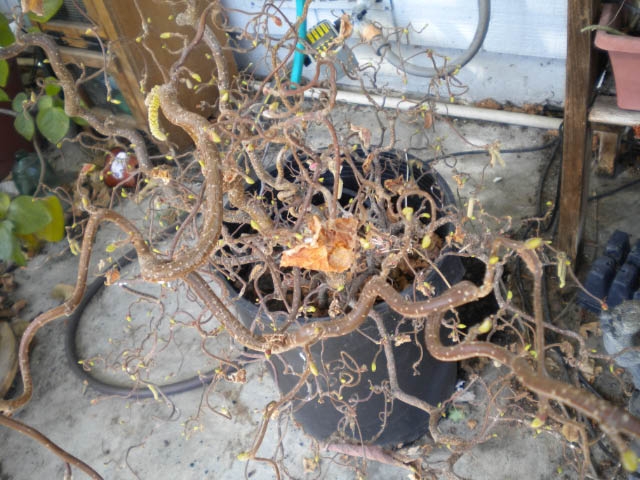
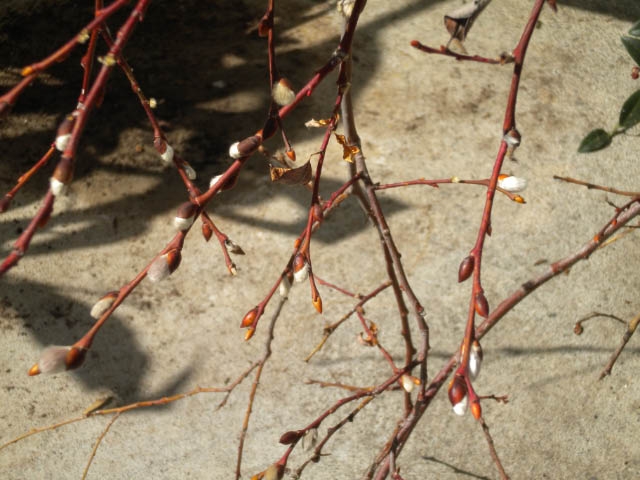
- Author: Patricia Brantley
Heir·loom \’er-,lÜm\: 1: a piece of property that descends to the heir as an inseparable part of an inheritance of real property 2: something of special value handed on from one generation to another. 3: a horticultural variety that has survived for several generations usually due to the efforts of private individuals.
My dad, Bob, passed away about 2 years ago, and I always think about him this time of year especially, since it would’ve been his birthday last week, and I undoubtedly would’ve brought him some home-baked cookies and a plant or garden tool. Every spring, when I was younger we’d go to a garden shop and buy a pansy or petunia for me to take home and keep in my windowsill. Since I didn’t live with him, I think it was his way of saying he’s always around.
Every time I went to my dad’s house something new seemed to be sprouting or growing. He was especially good with roses. Always telling me that they’ll grow if I’d just stick ‘em in the ground. One day I’d go to visit and he’d have them all pruned back and I’d think how in the world will they ever come back?
But, sure enough, next visit there they’d be with buds, and the next visit with big full blooms smelling wonderful with that old-fashioned rose scent. I’d often comment on my way to the car, and sooner than I could turn around, he’d have a few buds snipped with the stems wrapped in a moist paper towel so they’d stay fresh until I got home.
In another shady corner next to his shed were violets (Viola odorata), that were just prolific! Their tiny purple blooms fill the air with a light scent that you would imagine in a fairyland somewhere. Eventually, they spread to be under some of the rose bushes along with a bit of fern. What a treat for the senses that always was!
And every early spring, I’d always forget that there were daffodils. Since we usually entered in his back door I would never notice them until I would decide to take my “walk around” to see what was happening in his yard. I’d walk out to the front porch and practically staring me in the face would be the tallest daffodils! Mind you his porch was about 2 ½ feet high off the ground! Those would have to be the strongest bulbs I’d ever see, since they really had to reach to get some of the sun. I think he planted them for his wife, Harriet, who had loved the color yellow.
We finally sold his house last year as much as we wanted to keep it, it was in a senior living area and we weren’t allowed to rent it out. My husband waited patiently on the last moving day as I “walked around” one more time breathing in each scent and trying to remember it forever.
Just last week, I was doing a “walk around” of my own house, when I noticed something growing in a bin. It was my dad’s “compost” bin. Just an old 15 gallon black planter’s tub that he used to throw his clippings in after pruning. I guess I’d forgotten. I’d dug up some of those daffodil bulbs and tossed them in hoping that I’d be able to get the same spectacular results that he had gained. But alas, I never planted them. Disappointed and figuring that they turned to compost themselves after a year of sitting, I passed by the tub day after day never having the heart to recycle it and had decided to use it for my own trimmings. What a surprise! Those bulbs had grown and bloomed in his bin and there they were! Rejoice! Two perfect daffodils (I think one for Dad and one for Harriet), right in the bin, right at my house, just like he was saying again that he’d always be around.
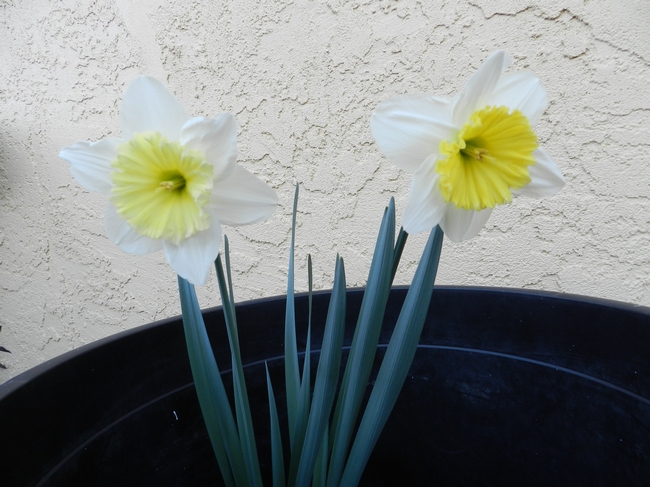
- Author: Betty Homer
Disclaimer: This article does not express the views held or advocated by UCCE or its affiliates with regard to biodynamic gardening or farming. It only seeks to introduce the concept of biodynamics to readers as another alternative system of sustainable gardening.
On the recommendation of another Master Gardener, I enrolled in an 8-month course at the Rudolf Steiner College in Fair Oaks, California, in my quest to learn more about different systems and methods of organic gardening. Last month’s lecture was on “Cosmic Rhythms, Planting Calendars.” Although I have not quite made up my mind about the efficacy of this planting system, it was/is nevertheless interesting to learn a new way (at least new to me) of backyard gardening.
One of the beliefs held by biodynamic practitioners, is that planetary/intergalactic events somehow relate to/have practical effects on plants on Earth. For instance, one of the lecturers at the seminar asserted that certain planets such as Venus and Mercury, directly impact the plants belonging to the rose and lily families, respectively, because the geocentric orbits of those planets correspond with the shape and appearance of plants belonging to those families. Although this assertion may or may not be true, the concept of inter-relatedness between celestial and terrestrial events, is both appealing and beautiful.
Planting according to cosmic rhythms is a very complex process, as many factors (i.e., the perceived location of the sun and moon, position of the planets and constellations/stars, the equinoxes, etc.) must be taken into consideration in designing a planting schedule and what tasks to do at a particular hour and on a specific day. While one can create his/her own calendar, the Stella Natura calendar is one of several calendars upon which biodynamic gardeners rely (be forewarned that biodynamic calendars may be a bit daunting to read for the beginner, as they are filled with all sorts of symbols representing where certain planets are believed to be positioned in the zodiac, the phases of the moon, and what conjunctions and oppositions exist as between the moon and the planets). Although inconclusive, some biodynamic practitioners claim and have documented that they have experienced a better, healthier crop yield when planting according to a biodynamic calendar. It is interesting to note, however, that one of the lecturers at the seminar stated that planting according to a biodynamic calendar is very difficult, if not impossible, on a working farm due to scale and the economic realities of operating a farm (i.e., margins being razor-thin). So will planting according to a biodynamic calendar give you better yields? As the lecturers at the seminar suggested, consider experimenting and decide for yourselves.

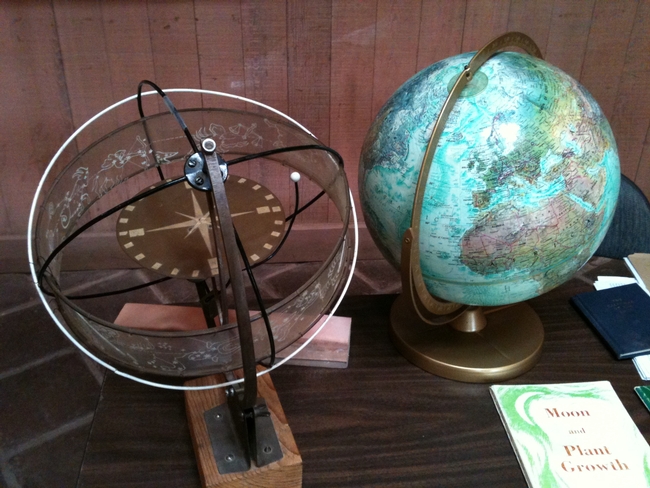
- Author: Sharon L. Rico
Usually this time of year is cold, wet and dreary. Being indoor bound, one does not appreciate what’s happening outdoors. In years past being indoor bound, my free time was spent reading the seed and plant catalogs that arrived in the fall, and planning a spring garden. Not so this year! With most days in the 60's and a few in the 70's, the garden beckons. I am not one to begin chopping down the plants that have frost bite, there are other garden chores to enjoy instead. Plants that are bulging out of their containers can be transplanted to larger pots. Thinning the clumps of callas and wild wood violets is an ongoing project. Moving statuary and garden art to enhance plans for staging the garden this year is another sunny day project. Spending this time outdoors has brought awareness of the surrounding colors. Everything seems to be blooming more abundantly (for February). The bright white calla spathes are unfolding, as I write. The daphne (Thymelaeaceae), with its tiny clustered pink bells, perfumes our shade garden. Camellias (Theaceae), are either in full bloom or covered with swollen buds. One camellia, named ‘Pink Perfection’, is covered in light pink blooms from top to bottom. Azaleas bloom along the shady walkway and in containers. The hardenbergias purple sweet pea-looking blooms, cascade over the wine barrel that has been its home for 20 years. Bright yellow primroses (Primulaceae), bloom at the base of the Rose of Sharon tree (Hibiscus syriacus), and yellow daffodils are opening up in containers and along the driveway. The Lisbon lemon tree has bright yellow lemons glowing from its lower branches, resembling a lopsided Christmas tree. The yellow oxalis flowers are poking up through the celery and among the sweet peas. Native to our garden, I suspect the oxalis has been growing here since 1930. Hanging baskets of red, white and pink cyclamen (Primulaceae) brighten the front porch and side yard. Blue wood violets show up everywhere, including in the middle of the lawn. In the next month or so, the tulips will bloom, followed by roses, sweet peas and iris, adding additional color to the garden. Winter’s sunshine is the time to enjoy being outdoors this year and we’re doing it!
